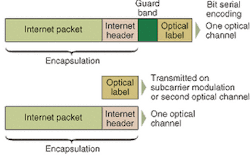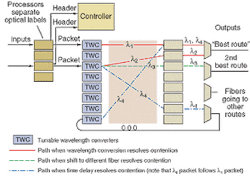
Today's all-optical switches are fundamentally mismatched with the needs of the fastest-growing sector of telecommunications—the Internet. The current generation of optical switches are circuit switches, which make optical connections between network terminals. The Internet, however, is built on a radically different process called packet switching.
Modern network architectures were developed for electronics, which can handle both circuit connections and packet switching. Optics can switch circuits, but optical packet switching has proved more difficult. A handful of developers are making encouraging progress, but still face some tough issues.
Circuits and packets
Circuit switching evolved from the voice telephone network, where its original purpose was to form an electrical circuit connecting two telephones. In the modern telephone network, wires carry electrical voice signals between individual phones and a point in the network where the calls are digitized and time-division multiplexed into data streams. The system assigns each voice circuit 64 kbit/s of capacity in the data stream, which remains committed to that voice circuit until the call is completed. This logical connection guarantees transmission capacity between two phones. Today's optical switches handle composite signals assembled by multiplexing many voice circuits, but the principle is the same—the switches form an optical connection between two devices or points.
The Internet transmits data in blocks called packets; each packet includes a header that specifies its destination. Packet switches—called "routers" on the Internet—read the header, interpret the address, then direct the data out a suitable port on the route toward its ultimate destination. A packet generally passes through a series of routers on its way to its destination, with each one reading the header and deciding where to send the packet.
Packet switching uses limited transmission capacity much more efficiently than circuit switching. In contrast, circuit switching guarantees that a certain capacity is available, whether or not it is all used. Voice telephony and video transmission are services that need a certain channel capacity because their signals flow uniformly and are delay sensitive. Computer data transmission uses packet switching because it flows in bursts rather than evenly, and because it is not as sensitive to delay. Packets or bundles of computer data can be queued until the system is ready to transmit them, a process called statistical multiplexing. This means that transmission capacity depends on the average load, not the peak number of circuits, resulting in increased efficiency—like a parcel service that can fill an entire truck with packages before dispatching it to its destination.
To achieve this high efficiency, packet switches must be "smarter" than circuit switches. A packet switch must read the header on each packet, store the data while figuring out what to do with it, then transmit it to the proper destination, perhaps with a revised header. This requires cache memory to store the data packet while the switching decision is being made, processors to decide the data path, and some way to switch the outgoing packet to the proper destination.
Electronics have done the job well, but developers are looking to optics to handle future higher data rates and volumes. The trick with optical packet switching is to perform these functions optically.
The role of optics
No one expects optics to do the whole job of packet switching. Electronics will initially package the data payload and apply the header that specifies its destination. When this electronic packet enters the optical part of the system, it is encapsulated into an optical packet, and a separate optical label (equivalent to a header) is applied to carry the optical routing information. The label and data need not be transmitted at the same rates because they are processed separately, so a 2.5-Gbit/s label could be attached to a 10-Gbit/s packet.
Different configurations are possible for the optical label (see Fig. 1). One possibility is to transmit the label bits serially, as an initial block data preceding the encapsulated data packet. An interval called the guard band separates the optical label from the body of the packet, giving time for the system to start processing the label information before dealing with the encapsulated data. An alternative is to transmit the label in parallel with the encapsulated packet, either via subcarrier multiplexing on the same optical channel as the data, or on a separate optical channel using wavelength-division multiplexing.
The optical label is converted from optical to electronic form to be read, while the encapsulated packet remains in optical form. This process is carried out by diverting part of the optical signal to an electronic receiver, or by filtering if the optical label is at a different wavelength. Electronics then process the label and use that information to control a switching matrix that directs the optical packets (see Fig. 2). They also generate a new label to be applied to the packet as it leaves the switch.Operations on the optical label are not performed instantaneously, so the encapsulated optical packet must be placed in a temporary buffer storage. If all packets are the same known length, a packet can be stored by passing it through a length of fiber or another type of optical delay line, which delivers it to the switching matrix after the proper interval. That's unrealistic, however. Internet packets are variable in length, and packets may need to be held to resolve conflicts in timing and priority. A practical buffer storage should be able to hold variable-length optical packets for different intervals, until the switching fabric is ready for them. Developing an optical version has proved to be a very tough problem. At OFC 2002 (Anaheim, CA, March 17-22), Julie Fouquet of Agilent Technologies (Palo Alto, CA) warned that the lack of an optical buffer memory could make optical packet switching impossible, but many showed no signs of giving up.
Seeking switching speeds on the order of a nanosecond or less, developers of optical packet switches are focusing on redirecting packets by converting them to different wavelengths. Converters based on semiconductor optical amplifiers can meet those speed requirements. Daniel Blumenthal of the University of California at Santa Barbara (UCSB) said at OFC 2002 that his group has switched signals between any two pairs of 36 standard optical channels within 5 ns. The signals at the shifted wavelengths can be carried through the same output fiber on different wavelengths, or routed through a passive arrayed waveguide demultiplexer to divide them among different output fibers.
In additional to switching wavelength, the converter can be used to erase the old optical label and write a new one on the packet, to guide it on the next leg of its journey. Using only optics, the technique is called all-optical label switching.
Demonstrations
Several groups reported optical packet switching research at OFC 2002. S. J. B. Yoo of the University of California at Davis described a novel switching fabric that resolved contention between packets in three dimensionswavelength, time, and space. The first step, when two optical packets sought to be transmitted through the same fiber at the same time, was to convert one packet to a different wavelength for routing through the same fiber. If no further wavelengths were available on that fiber, the switch converted one packet to a different wavelength so an arrayed waveguide delivered it to a fiber loop that delayed it by 835 ns, longer than the packet length, before returning it to another input. That input routed the delayed packet through the main output fiber behind the first (see Fig. 3). If the delay line was also occupied, the switch could shift the packet to yet another wavelength, which the arrayed waveguide delivered to a second fiber that offered an alternative route. Yoo claimed error-free performance in the tests.In a postdeadline OFC 2002 paper, Lavanya Rau, Blumenthal, and colleagues from University of California Santa Barbara reported all-optical label swapping to switch variable-length 80-Gbit/s packets with 10-Gbit/s headers over two hops. Demonstration of such high-speed operation is important because it highlights a key advantage of optical packet switching—its potential to handle faster signals than electronics. They realized that function with a recently developed fiber cross-phase-modulation wavelength converter which promises speeds above 100 Gbit/s. Demonstration of two hops also is encouraging, because packet switches must be able to operate in series in any practical network.
Some researchers have begun looking at alternatives to traditional packet switching that they believe fit better with the capabilities of optics while enhancing performance. One example is a flow-switching technique described by Bishwaroop Ganguly of the Massachusetts Institute of Technology (MIT) Lincoln Laboratory (Lexington, MA) described in a regular-session paper. He used conventional optical circuit switches to direct bursts of 40-Gbit/s data between pairs of points for a second or less. He says that careful scheduling of high-speed data flows for short intervals can allocate system resources efficiently with readily available optical switches, bypassing expensive electronic routers, as well as providing the guaranteed quality of service available only with connections.
Looking forward
Nobody thinks commercial optical packet switching is just around the corner, but Blumenthal believes that scalable, deployable systems could be ready in 5 to 10 years. Others, like Fouquet, are less optimistic because of the formidable problems posed by the lack of an optical buffer memory. A few, like Ganguly and his coworker Vincent Chen of MIT, are looking for new architectures.
Prospects also will depend on the state of the telecommunications market, and whether plans to move to higher serial data rates—40 Gbit/s and up—come to fruition. Although most observers expect the market to recover, few expect anything like a return of the headlong growth during the telecommunications bubble. Among the key questions to be answered is whether the economics will favor transmitting a few channels at 40 Gbit/s and up, or more channels at 10 Gbit/s.
FURTHER READING
D. J. Blumenthal, Opt. Networks Mag. (Nov/Dec 2001).
About the Author
Jeff Hecht
Contributing Editor
Jeff Hecht is a regular contributing editor to Laser Focus World and has been covering the laser industry for 35 years. A prolific book author, Jeff's published works include “Understanding Fiber Optics,” “Understanding Lasers,” “The Laser Guidebook,” and “Beam Weapons: The Next Arms Race.” He also has written books on the histories of lasers and fiber optics, including “City of Light: The Story of Fiber Optics,” and “Beam: The Race to Make the Laser.” Find out more at jeffhecht.com.


